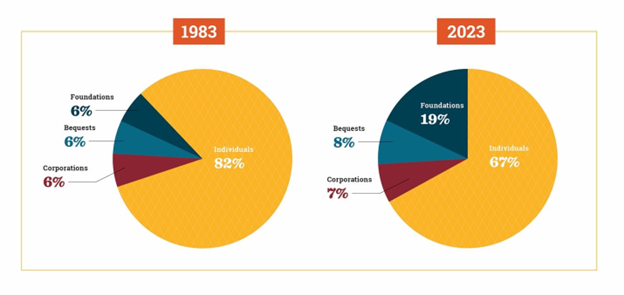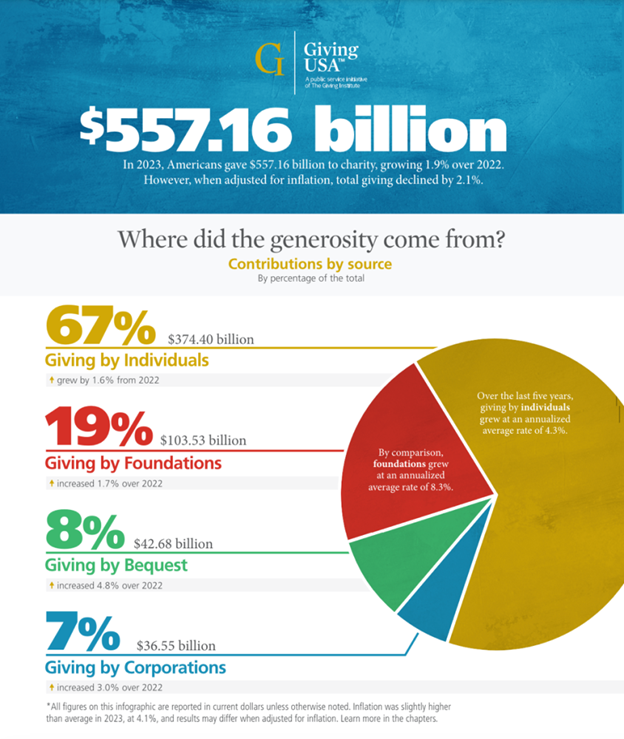If recent history has shown us anything, there are virtually no guarantees regarding funding sources. We’re all living in a world of Fundraising Disruptors (FD). If you’re in the nonprofit sector, or even the community at large, you’ve likely seen one or more of the scenarios below cause a well-loved organization to struggle financially and, as a result, programmatically:
- A major donor that was heavily relied on reduces their level of support or passes away
- A downturn in the market impacts ALL your donors simultaneously, leaving you with a gap and a shortage of donors to help fill it
- Layoffs impact a parent’s ability to pay for private school tuition
- Natural disaster; COVID, hurricanes, fires, and tornadoes prohibit the biggest fundraiser of the year from happening
- Perception or actual impropriety impacts church attendance and thus hurts weekly giving
- New government administration trims funding budgets
- Another nonprofit serving the same mission opens near you, thus confronted with competition
Founded in 1979, the same year Sony Walkman’s hit the market, Ruotolo Associates (RA) has worked with over 1,800 clients in varying seasons of abundance and scarcity over the last 45 years. We have witnessed FD’s that were on the horizon and those that nobody could have ever predicted. What we’ve learned is:
- Majority of Fundraising Disruptions that significantly impact annual budgets are out of the leadership’s control. Yet only a minority of nonprofits have tangible plans to navigate rough waters. YOU MUST HAVE A PLAN!
- Most nonprofits rely too heavily on one funding source and forget that EVERY FUNDING SOURCE IS VULNERABLE!
As the side-by-side comparison shows, funding shifts in philanthropy are not stagnant. At Ruotolo Associates, we urge our clients and their boards to pay close attention to their funding sources, take the time to consider potential FD’s, and identify which of their funding source(s) they may have become too reliant on.


Whether you are a Board Member, CEO/Executive Director, or Development/Advancement Director, you have a role to play in helping your beloved organization avoid becoming a victim of an FD. Here are some questions to get you started:
- As a Board Chair – When did you last discuss the funding sources most vulnerable in the budget and the CEO’s action plan at a Board meeting? How long could the organization go if one of its most significant line items was cut entirely? Are there any requirements of the Board during a time of crisis?
- As the CEO/ED – What key action steps will you take as the leader during a crisis? When staff members have water damage to their homes from a hurricane, what are the expectations for them when they come into the office? If the workplace is destroyed, where will your temporary headquarters be located? How will those you serve be impacted, and how will you shift funds to ensure service continues? If you want donor support, you must keep the lights on and the program operating.
- As the Development/Advancement Officer – Which donor will you call first, second, and third? How will you approach them, and what will your “ask” be to ensure your message is heard among the other nonprofits impacted? Are you asking them to give to a general fund or something specific? Can you anticipate their reaction to your request?
During this process, identify the opportunities or strategies you could lean on for the immediate, short-term, and long-term. And just as important, identify where you have gaps. Questions such as, “If we could not host our gala today, what would we do to meet our annual goal?”. Or asking, “If we could go back in time and prepare for ABC (COVID/Hurricane Milton), what would we have done differently?” will shed light on where you need to focus your efforts.
Donors will also appreciate the forethought and planning your organization has put into this process. As we hear about donor fatigue and distrust growing in philanthropy, this could also be a tool or a talking point to demonstrate to your donor that your organization is thoughtful in times of comfort and crisis.
Here are some additional questions to help you and your team as you think about FD’s:
- When was the last time you identified your risk level and created a plan with leadership to navigate through?
- With the unpredictability facing nonprofits, what is your organization doing TODAY to prepare for FD’s?
- What is your game plan to ensure those who have come to rely on you can continue to have faith that you will be there post-storm or in a tough economy when they need you the most?
Exactly five years ago, the pandemic changed things on a dime with an event that nobody could have ever predicted. It was a once-in-a-hundred-year event. 100% of nonprofits in the United States were impacted. Now, what percentage of those nonprofits have a plan in place today should there be another FD like COVID-19? Fundraising Disruption planning must be baked into every nonprofit’s annual planning process when discussing budgets and resources.
The panic that ensued because of the potential spending freeze from D.C. demonstrates many organizations’ reliability on funding sources outside their control. There is a clear need for nonprofit leadership to be prepared before calamity strikes and have an emergency funding plan. No organization is immune to Fundraising Disruptors. It’s not a matter of if; it’s a matter of when.

